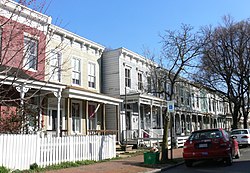Oregon Hill
|
Oregon Hill Historic District
|
|

View down Laurel Street in Oregon Hill
|
|
| Location | Roughly bounded by W. Cary St., Belvidere St., Oregon Hill Park, S. Cherry St. and S. Linden St., Richmond, Virginia |
|---|---|
| Coordinates | 37°32′24″N 77°27′7″W / 37.54000°N 77.45194°W |
| Area | 84 acres (34 ha) |
| Architect | Noland & Baskervill; Martin, Baylor S. |
| Architectural style | Late 19th And 20th Century Revivals, Late Victorian, Federal |
| NRHP Reference # | |
| VLR # | 127-0362 |
| Significant dates | |
| Added to NRHP | February 05, 1991 |
| Designated VLR | December 11, 1990 |
Oregon Hill is a historic working-class neighborhood in Richmond, Virginia. Oregon Hill overlooks the James River and Belle Isle, and provides access to Hollywood Cemetery. Due to the neighborhoods proximity to the Monroe Park Campus of Virginia Commonwealth University, the neighborhood is sometimes referred to as a student quarter because of its high college student population.
William Byrd III established a rural estate on the property in 1758. Wealthy heiress Grace Arents helped build many institutions to serve the community.
In 1758, William Byrd III built his country house Belvidere on this hill, with views of the James River as well as Church Hill (Richmond, Virginia) and Shockoe Hill. Fire destroyed the house and gardens about a century later, by which time the neighborhood had transformed from an agricultural to industrial one. Construction of the James River and Kanawha Canal beginning in 1785 brought not only boatman, but merchants, millers and iron workers to the neighborhood.
Important Quakers who lived in the Oregon Hill neighborhood included Robert Pleasants, and later Samuel Pleasants Parsons, who became superintendent of the Virginia Penitentiary, which once stood on Belvidere Street. As General Superintendent of the canal company, Parsons oversaw its expansion to Lynchburg, Virginia. In 1817, the Harvie family, which owned most of the neighborhood, subdivided it into lots, which were sold to blacks as well as whites. The Baker House, built by a "free person of color" on Belvidere Street circa 1850, was moved in the 1920s to 617 Cherry Street. The neighborhood's name refers to quips that employees moving there to be close to their workplace might as well be moving westward to Oregon. The Tredegar Iron Works and Albemarle Paper Company became major employers by the 1850s. In 1849, the Hollywood Cemetery was developed from what had been known as Harvie's Woods at the edge of the neighborhood.
...
Wikipedia
